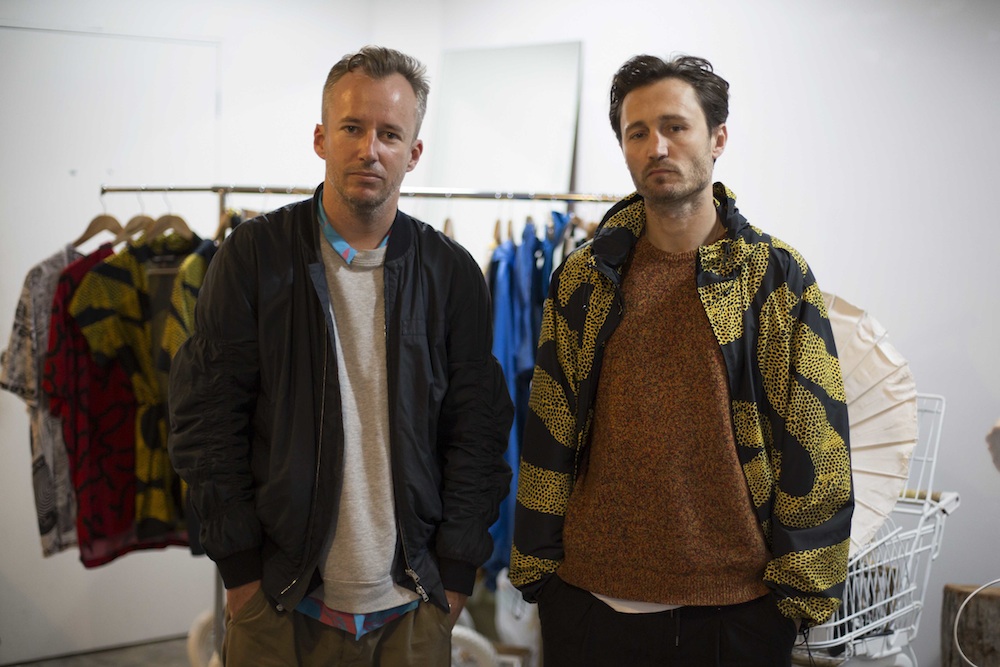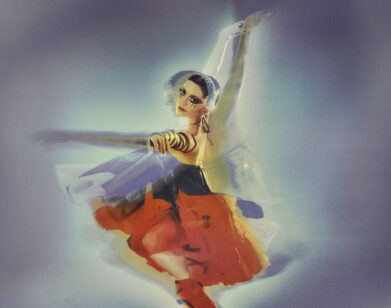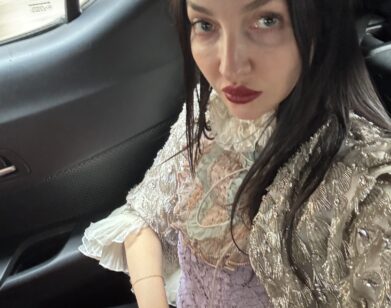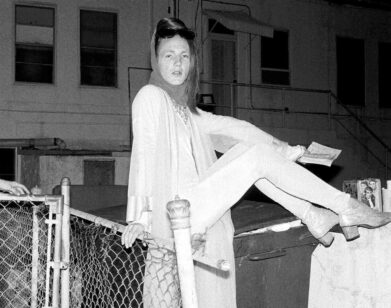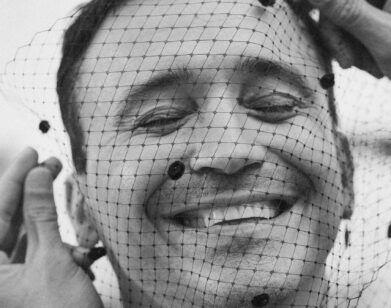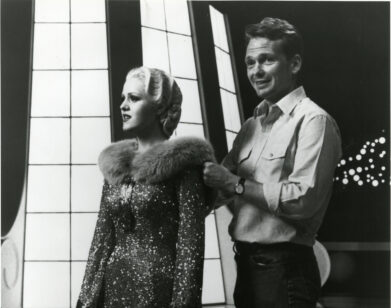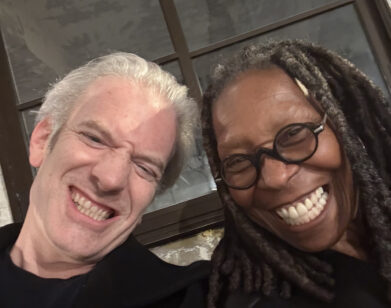Discovery: Double Rainbouu
PHOTOS: NATE PALMER.
The tagline on Double Rainbouu’s website is straightforward and catchy: “Resort wear for beach babes and pool punks.” Established by Toby Jones and Mikey Nolan in January of 2016, the Australian label began with five different styles of Hawaiian-inspired printed shirts. Over the last 18 months, this offering has expanded to include knitwear, slouchy trousers, board shorts, and bathing suits, bridging the gap between beachwear and playful contemporary fashion. Next up is a sunglass collaboration with Le Specs.
Based in Sydney, Jones and Nolan first met in the early 2000s while working at the surf brand Insight, and reunited several years later when Jones joined Nolan at Ksubi. When the duo left denim brand in 2013, both planned to change their career paths. “We were originally like, ‘We’re not doing any more fashion stuff,'” explains Jones. “But you get drawn back in.”
“The last few years at Ksubi were kind of intense,” Nolan adds. “It was quite an elaborate beast and we tried to do a lot of things, a lot of ideas,” he continues. “We wanted Double Rainbouu to be relatively simple. We’re not going to change the shapes much; classic shapes, simple fabrics, and changing the prints.”
Last week, Double Rainbouu, whose stockists already include Opening Ceremony and Barneys New York, participated in Pitti Uomo in Florence. We spoke with the design duo at their studio on a rainy Friday afternoon in May during Mercedes Benz Fashion Week Australia.
HOMETOWNS: Toby Jones: I grew up North Coast, about six hours north of Sydney.
Mikey Nolan: I was actually born in Singapore and lived there until I was five. But my whole family is from Sydney.
Jones: We both grew up at the beach. I think we identify with that—having a life spent at the beach. It’s not a necessarily a holiday thing, it’s more every day, any day of the week.
FAMILY BACKGROUNDS: Jones: My family is pretty creative, but they’re not really artists. My dad’s a furniture maker; he always says he’s not “artsy-fartsy.” I’m like, “Dad, you’re an ex-hippie in denial furniture maker who spends most of his time surfing or bush-walking. I don’t know what you think ‘artsy-fartsy’ people are, but you’re pretty much one of them.”
Nolan: My dad went into manufacturing and my mum was a social worker.
BUILDING DOUBLE RAINBOUU: Nolan: It’s been pretty quick. We started with a single-category brand—a kind of random niche idea—which people found a bit quirky. We were just this Hawaiian shirt brand.
Jones: We only had Hawaiian shirts. We had five shirts and that was it.
Nolan: One shape, five prints. It was always our intention to grow it into something more, but we weren’t totally sure that it would get the good response it’s gotten. In a year and a little bit, it has grown into quite a well-rounded thing that people get as a 3-D experience. We like creating a culture around the brand and engaging intelligently with popular culture. We did think, “Let’s do something simple and something that people look to Australia for.” People do look to Australia for beachwear and casualwear.
Jones: We didn’t want to be a fashion brand; we wanted to be a fun, beach brand.
Nolan: To be honest, we actually thought we’d sell way more board shorts than anything else. It’s been received really well in a contemporary fashion way, which is awesome. We just bought 500 shirts and said, “We’ll start our online store.” We sold to a few boutiques here just to test, and then we got an order from Opening Ceremony. The first collections had a 95% sell-through there, so they ordered another season. Then we got an order from Barneys. It’s been sitting in the fashion world, which is good. It’s beachwear that is dabbling in the international fashion conversation.
STICKING TO YOUR STRONG SUIT: Nolan: Our strength is print design. We’re not fashion designers—we’ve worked in fashion for a long time, but our background is print design and visual communication.
Jones: Print and marketing.
Nolan: That was part of the reason why we did Double Rainbouu. We were like, “What items of clothing are there that even not that loud a person is quite willing to be a bit loud in?” And [we thought] Hawaiian shirts and swimwear, and then knitwear. We’re not going to do printed blazers; we just keep to the classics where people are willing to have a bit of fun.
PICKING A PRINT: Jones: We go through too many—I’d say a hundred versions of them. We burn through a lot.
Nolan: It’s pretty amazing how many we go through. From however many years at Ksubi, we’ve got so many folders of graphics that never made it anywhere. We’ve always thought it would be a good idea to make a book of all the graphics that never surfaced. The process is so interesting, just seeing everything that falls by the wayside. There’s some hilarious stuff, some hideous stuff, and some really good stuff.
Jones: I always think the best prints are the fastest ones. We’ve done thousands of T-shirt graphics over the year, and definitely my philosophy for that is the faster the better.
Nolan: Same. Textile design and print design, I like to spend a bit more time on. Possibly we overthink them a little bit.
Jones: Probably two of the better prints [from our Resort 2018] were the last two; we just threw them in at the end and they were so quick to do. But it took us a month or something to get through all that other stuff to go, “Oh yeah, those ones. Should have just done them.”
DECIDING DISAGREEMENTS: Jones: In the last couple of weeks we’ve been disagreeing a fair bit.
Nolan: We loathe each other sometimes. [laughs] One person just gets really rigid and just doesn’t move.
Jones: We just push it through.
Nolan: We’re fine. We’ve sat next to each other working for ten years. We’re both pretty chill guys. If we have a fight, we’re fine two seconds later.
MEDITATIONS AND EXPLORATIONS: Nolan: We go on a few tangents with a theme. With Resort 2018, we were like, “Let’s do a take on holiday. Let’s look at Goa and Ibiza in the ’70s—the idea of escape, and what are you escaping for, and what are those utopian places and what do they become when they become kind of ugly?” I was watching a documentary on Viceland about this place in Romania on the Black Sea, a holiday place called Vama Veche. It was this hideous place, but it was great in the ’80s. I’ve been to Ibiza and there are beautiful aspects to it and there are really ugly aspects.
We were interested in that, and that led us down a little side trip via acid house, and then we started looking at this Japanese psychedelic artist from the ’70s, and utopian and dystopian things. There are hippie, pretty prints and then there are serpent motifs and the fawn motif, which is alluding to something a little bit more dark. Then that colorful landscape with the red trees, it’s almost neon, radioactive colors, so it’s meant to be slightly dystopian, but still having fun at the same time. We’re a beachwear brand and we can’t get too serious, but we do want to have some kind of commentary even in that medium. A lot of the beachwear brands out there are just a little bit bland and lack any kind of cultural focus. We want ours to be a bit more engaging.
FOR MORE ON DOUBLE RAINBOUU, VISIT THE LABEL’S WEBSITE.

